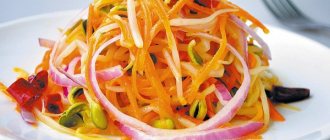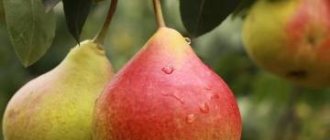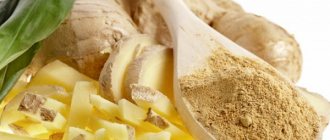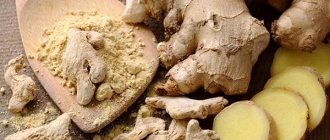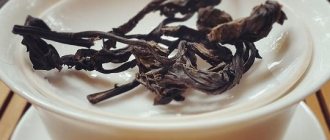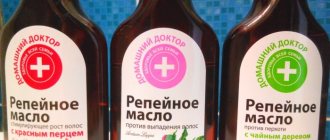Ginger components: nutrients, vitamins
Ginger, or rather its root, is rich in amino acids, essential oils, vitamins and minerals. The list includes antioxidants - elements that preserve female beauty. Thanks to the following components, premature skin aging will be avoided:
- Magnesium;
- Polyphenols;
- Vitamins: A, C, E;
- Zinc.
The properties of ginger on a woman’s body are very beneficial due to the vitamins and microelements contained in this miracle root.
These substances act in a complex manner. They help in the production of new and healthy skin cells while repairing old ones.
The properties of ginger, which have a positive effect on a woman’s body, also protect against symptoms that can be caused by poor metabolism. Regular use of the product can improve the digestion of even “heavy” foods containing fats, carbohydrates, and proteins. All this becomes amino acids, sugars and lipids - especially necessary for the body.
To strengthen the lungs and bronchi
19.08.2020
A person cannot live without oxygen. The lungs saturate the body with oxygen and cleanse it of toxins and carbon dioxide. But for the health of the bronchi and lungs, you need to eat well.
More useful products
Good nutrition enriches the body with minerals and vitamins, proteins and fats necessary for respiratory health. Many people now lack them, including due to poor ecology. The main enemies of the lungs are oxidants; they accumulate when inhaling dirty air and tobacco smoke. The lungs are also threatened by bacteria, viruses, and various allergens that lead to inflammation. Therefore, it is beneficial to consume vitamin-rich and nutritious foods with antioxidants, anti-inflammatory properties that help with cough.
- Broccoli is a source of vegetable oil. Contains many vitamins, including vitamin C, it is a strong antioxidant and immune .
- Olive and butter oils are rich in easily digestible fats, vitamins A and E, necessary for lung and mucus removal.
- Honey disinfects and thins mucus, helps with coughs, and enhances gas exchange in the lungs . Honey contains almost all the necessary vitamins and minerals.
- Carrots are rich in beta-carotene, which nourishes and strengthens lung .
- Meat is a source of B vitamins and proteins.
- Fish contains Omega-3 fatty acids, beneficial for gas exchange and tissue repair. Seafood also contains cell-regenerating vitamin D and iodine.
Useful minerals
An elderly person often lacks calcium and sometimes iron, both of which are beneficial for lung .
- It is necessary to monitor the level of hemoglobin in the blood . Hemoglobin is contained in red blood cells, which participate in gas exchange. They are saturated with oxygen in the lungs , and then distribute it to all organs. Therefore, the diet for pulmonary patients includes foods that are recommended for anemia. In this case, beets help. It increases hemoglobin and enhances gas exchange, cleanses and disinfects the bronchi.
- Calcium is also necessary. It affects neuromuscular conduction and the contraction of muscle tissue. Calcium heals damaged lung after pneumonia . If there is not enough of it, then allergic reactions , swelling, decreased immunity , fatigue increases, which means the possibility of infection entering the lungs . therapists increase the daily calcium intake for pulmonary patients Cottage cheese and cottage cheese are rich in calcium.
Recovery after illness
To recover faster from diseases of the lungs and bronchi, it is necessary to restore tissues damaged due to infection, improve gas exchange, strengthen the immune system and increase overall tone. Then diet No. 11, which is recommended for tuberculosis and pneumonia, .
With this diet, you can eat many familiar foods, but patients need more calories. Very healthy plant and animal proteins.
- Broccoli is rich in plant proteins.
- Fats that are easily digestible are also needed. But an excess of beef and lamb fat will not be beneficial for the body.
- You don't need to eat a lot of buttercream pastries - at best they will be useless.
- In general, it is better to consume less sugar and salt.
- Eating eggs is good for you; they contain almost everything you need.
The daily menu should include not only fish, dairy and meat dishes, but also vegetables and fruits rich in vitamins and minerals. In this case, it is advisable to eat fractional meals, then all the beneficial substances are absorbed faster.
You can drink any drinks except alcohol, but the healthiest ones are decoctions of rose hips and hawthorn, freshly squeezed juices and fruit drinks. To cleanse the body of toxins, it is useful to drink clean water, at least 1.5 liters per day.
Published in Pulmonology Premium Clinic
Ginger against inflammatory processes
Ginger root has a positive effect on a woman’s body, and its properties prevent diseases from progressing. Not only do they prevent it from progressing, but they also fight inflammation with a shock dose of nutrients (the plant copes with various types of viruses, bacteria, fungi and parasites).
Ginger helps treat inflammation in joints
In what cases is it especially worth taking ginger root:
- For joint pain;
- For painful sensations during the menstrual cycle (ginger tea helps);
- For infertility.
The last point, according to medical experts, is an absolute godsend for a woman diagnosed with infertility. The plant easily improves blood circulation, so that oxygen and other beneficial substances reach the genitals in the required quantities.
Benefits of ginger
This root has a lot of medicinal properties, which were known back in ancient Rome. Tea was brewed from it, pieces were chewed to protect and cure the body from many ailments .
The beneficial effects of the spice were used to treat impotence and other diseases in men. Today it is also used not only as a spice in cooking, but also as a medicinal product.
Chemical composition
The healing qualities are due to the chemical composition of the plant, the presence of a huge amount of vitamins E, K, C, A and B, minerals, fiber, essential oils, biologically active substances, and macroelements. Substances contained in the plant: chromium, sodium, calcium, manganese, silicon, iron, magnesium, phosphorus, leucine, tryptophan, choline, threonine.
Ginger is also rich in nicotinic, linolenic, caprylic, and oleic acids. It also contains compounds rare for other products: cineole, borneol, zingiberene, phellandrene, citral, bisabolene. The calorie content per 100 g of this product is only 80 kcal.
You might be interested to know the difference between ginger and turmeric.
By nutrient content:
- proteins - 17.7 g;
- fats - 0.7 g;
- carbohydrates - 1.8 g;
- dietary fiber - 2 g.
The root is famous for its lack of cholesterol, which is why it is recommended for people suffering from atherosclerosis. Thanks to such a wide chemical composition and spicy taste, ginger root is used both for the prevention of diseases, increasing tone, and in the treatment of pathologies.
Effect on the human body
The healing properties of the root are popular among adherents of traditional medicine. It has a unique composition, thanks to which it is famous for its antiemetic, diaphoretic, anti-inflammatory, and tonic effects. The substance gingerol contained in the composition warms the human body from the inside , tissues receive abundant saturation with nutrients and oxygen, which leads to vasodilation and accelerated metabolism.
Find out how to cleanse your body with ginger.
The use of the root strengthens the immune system, relieves inflammation, swelling, and helps fight obesity. Also recommended for helping cancer patients. This spice is recognized as a good remedy for strengthening blood vessels. It helps lower cholesterol and helps prevent blood clots.
- Ginger is recommended to be taken for:
- headaches;
- nausea and toxicosis;
- dysbacteriosis;
- thrombophlebitis;
- inflammation of the joints, to relieve swelling and pain;
- colds, to improve the general condition of the body.
Contraindications and side effects
If a person is healthy, use is unlikely to cause harm to the body. However, if consumed excessively, the beneficial properties can lead to bad consequences: instead of calming, they will lead to insomnia, lethargy, or excessive agitation.
- People with the following diseases should also avoid using this spice:
- Oncological diseases of the stomach or intestines. The substances contained provoke the growth of diseased cells. However, in the case of other manifestations of oncology, the spice can reduce the growth and development of cancer cells.
- Ulcers and erosion of the gastrointestinal tract due to irritation of the mucous membrane. Sharp pain, indigestion and heartburn may occur.
- Hepatitis, liver cirrhosis.
- Hemorrhoids with bleeding: due to blood thinning, a profuse flow may begin that is difficult to stop.
- Allergy to ginger.
- Heart disease, ischemia, pre-infarction condition.
- Skin diseases - swelling and irritation may occur.
- Stroke.
- Hypertension.
Ginger helps you lose weight
Ginger is rich in gingerol, which, in turn, helps to effectively burn excess fat deposits. This element, present at the root, helps speed up metabolism, and also, importantly, prevents vomiting and improves the functioning of the pancreas.
Improper digestion, and therefore excess weight, will no longer be a concern if you regularly take ginger root. In order for metabolism to normalize, you need to take up to 2 liters of ginger tea per day. According to doctors' recommendations, for excellent results, you can add medicinal herbs, honey, cinnamon or lemon to the drink.
Taking herbal remedies during pregnancy
The root (in any form), added to familiar dishes, will boost women’s immunity, especially if a new addition is expected in the family. And yet, fresh ginger is considered the most useful for the prevention of diseases , since it retains all the beneficial properties than the heat-treated or dried version.
Experts recommend in the morning, after 10 minutes. after sleep, eat a small thin piece of pre-cooked ginger root (chew it like chewing gum). This procedure promotes easy awakening and good mood.
During pregnancy, it is very important to keep your mouth immaculately clean. During this period, the body is especially susceptible to the negative influence of pathogenic bacteria. At the same time, frequent use of toothpastes and dental lotions can harm the health of mother and baby, because it’s all chemicals. Therefore, the antiseptic properties that ginger root is rich in are simply irreplaceable in this situation.
Drinking tea daily will keep digestion in good shape and also support the general health of the pregnant woman. The same antioxidants will rid the body of toxins, which will only have a positive effect, including on the fetus.
Reminder for toxicosis and panic states:
| When to take the root | How it works and in what form to take ginger |
| In the first stages of pregnancy (1st trimester). | Ginger tea will help with nausea; it has a positive effect on the female body, and its properties easily quench toxicosis and normalize the functioning of the gastrointestinal tract. |
| For panic attacks (can only be taken during the first half of pregnancy). | The same tea will help. The drink will relieve sudden anxiety states. |
A pregnant woman can afford to drink very weak ginger tea (without additives) whenever she wishes (but no more than 1 liter per day).
Use by women
Every woman wants to look beautiful and feel young and resorts to different ways. One of them is the use of ginger.
When losing weight
First of all, the spice is justifiably considered a natural antidepressant: it suppresses the production of the stress hormone cortisol, which preserves human energy resources, and regulates carbohydrate metabolism. For this reason, a frequent accompaniment of stress is eating problems and consuming large amounts of “food waste.” Accordingly, the less cortisol, the less fat deposits.
Did you know? In 2010, scientists conducted a study that examined the effect of ginger on reducing soreness (muscle pain) by a quarter after exercise.
The root regulates the digestion process by stimulating the production of saliva, gastric juice, and pancreatic secretion. The substance gingerol (which is the source of the burning taste) helps speed up metabolism (metabolism), due to a surge of heat in the body. Faster metabolism means faster weight loss. However, the spice and its derivatives are contraindicated in patients with type I diabetes.
In the treatment of colds
The root is excellent at fighting bacteria. It has been used for colds for several centuries as an analgesic, anti-inflammatory, and immunomodulatory agent.
It eliminates many symptoms:
- thanks to the essential oils contained , you can reduce sore throat;
- bactericidal properties help relieve a runny nose, and expectorants help relieve a cough.
When sick, the body experiences a lack of vitamins. Ginger is used as a supplement of additional microelements that are extremely necessary during this period: B vitamins, ascorbic acid, potassium.
Also read about whether ginger can be consumed at fever.
Also, biologically active substances can increase sweating, which will slightly reduce body temperature. However, you should be careful with this antipyretic: you cannot drink hot ginger drink during hyperthermia due to the warming effect, and when the temperature exceeds the barrier of +38°C, you should completely abandon it.
For gynecological diseases
Ginger root is good for women's health. The Journal of Reproductive Medicine published a study by Japanese scientists who created a drug based on the root and 12 other plant components. Testing the medicine on 100 sick women showed a positive result: in 56% of the subjects, the menstrual cycle was restored, egg maturation began, uterine fibroids were cured and adhesions in the ovaries disappeared.
Experiments are still ongoing, but infertile women have a chance to become mothers. Doctors recommend drinking herbal tea with ginger when planning pregnancy to strengthen the tone of the uterus, liver and kidneys, improve the functioning of the hormonal system, and during menstruation - to reduce pain.
“Medley” of the beneficial properties of ginger
- Aphrodisiac
The root is considered an aphrodisiac. Regular consumption of ginger tea will give a woman more sensuality during sexual intercourse. The plant power of ginger is aimed at saturating the organs with oxygen, including the genitals.
- Inhalation
The properties of ginger, which have a positive effect on a woman’s body, help even with nasal congestion. “Ginger steam” will save you from a cold or viral disease, which helps even better than inhalation with the notorious potato.
- SPA product
To improve the condition of the skin, ginger is indispensable. Hair and nails can also benefit from taking ginger. Even cosmetology is unthinkable without the participation of this product, because it contains vitamins (in addition to A and E): B1, B2.
Important to remember! You don’t have to be “sick” to see how beneficial ginger is. Drinking ginger tea in the morning will provide a boost of energy for the whole day, and in the evening it will calm you down and help you smoothly go to sleep. Thanks to “rituals” involving the healing root, you can completely forget about your bad mood.
When not to use ginger
Despite the exclusively natural origin of the panacea, there are still some limitations that should be taken into account when deciding whether to take ginger or not. Reasons for refusing ginger may include:
- Allergy to the product;
- Pregnancy after the first trimester;
- Problems with the gastrointestinal tract;
- Heart problems;
At elevated body temperatures, ginger is contraindicated for use.
- Increased temperature (in this case, the properties of ginger will not have a positive effect on the female body; rather, there will be a risk of an even greater rise in temperature).
If a diagnosis or diagnoses take place, then the root will not bring the desired benefit. In addition, the product may even be harmful to health.
If ginger is new to the diet, then the first acquaintance with it should be “short-lived”. That is, you need to start with small portions. At the same time, mixing, for example, ginger tea with “notes” of green is contraindicated.
My own pharmacist
You can prepare “medicines” using ginger yourself. For each disease there is its own type of “ginger therapy” , which means its own recipe:
- If you are worried about joint pain
You can influence the disease through a decoction. To prepare, you will need ginger powder (about 3 pinches) and water (300 ml).
The crushed root is boiled for a little over half an hour, then filtered. The result obtained should persist. After 2-3 hours, the decoction is ready. It is best to take it with honey or sugar (or you can do both).
For the effectiveness of treatment, the drink replaces the usual tea or coffee and is drunk after breakfast, lunch and dinner.
A decoction of ginger and nettle will help with menstrual pain.
- If you are worried about pain during menstruation
A very simple recipe for which you will need:
- Grated ginger (fresh), 4 tsp;
- Stinging nettle (crushed), 1.5 tsp;
- Water, 1 l.
The ingredients must be brewed in a glass or enamel container after 10 minutes. The tea must be passed through a fine sieve. By taking the product daily, 1 glass 3 times, you can feel the sharp pain from spasms gradually disappear.
If the diagnosis is infertility
This case requires special attention and it is impossible to limit yourself to one recipe.
Specialists and workers at medical universities, who are closely studying the problem of female infertility, have immediately approved several of the most effective options for preparing the root to normalize the functioning of the woman’s genital organs:
| № | Ingredients | How to cook | How much to take (amount, time) |
| 1. | Nettle, raspberry, comfrey, dandelion, grated ginger ( it is very important that the number of elements is proportional to each other ). | Brew half a tablespoon of the collection per 200 ml of boiled hot water. Then let it brew for 10 minutes. Strain. | 3 times daily, after eating the main meal (drink no more than a quarter glass at one time). After 3 months of regular use, take a break. Repeat therapy after 1 month. |
| 2. | Stinging nettle (50 g), ginger (30 g). | Stir and pour 50 g of the mixture with a liter of boiling water. Let it brew for 20 minutes. Strain. | 2 times daily (1 dose – 150 ml of “nettle-ginger” tea). The terms are unlimited. |
| 3. | Turmeric is a type of ginger root, you will need 1 tsp. Honey (1 tsp), lemon slice. | Brew in boiling water (200 ml) in a glass container. Leave for 20 minutes. | Every day 3 times after eating the main meal. 1st dose is a quarter glass. Admission periods are unlimited. |
However, infertility treatment is a pressing issue. And, despite the plant origin of ginger, each recipe must be discussed with a qualified specialist.
Preparation
The root can be used in different ways: brewed as tea, added chopped to salads, used as a spice in various dishes.
Tea
It is important to use the spice correctly so that it imparts all its properties to the drink. By adding honey, lemon and cinnamon, you will get amazingly tasty, healthy, but with different purposes teas.
For warming tea you will need:
- boiling water - 200 ml;
- ginger - 1 tsp;
- lemon - 1 slice;
- cinnamon - 0.5 tsp;
- honey - 1 tsp.
Pour boiling water over ginger and cinnamon. Leave for 2 hours. Before use, add honey and lemon.
You will be interested to know how to properly brew ginger-lemon tea.
Recipe for tonic tea:
- boiling water - 1 l;
- honey - 2 tbsp. l.;
- cinnamon -1 stick;
- ginger - 50 g;
- lemon - 0.5 fruits.
Pour boiling water over all ingredients and leave for 3 hours. It is recommended to drink only in the morning, but not before bed, so as not to cause insomnia.
Pickled ginger
The use of pickled root is extensive and popular due to its usefulness and interesting taste. To get beautiful pink ginger, use the following recipe.
Ingredients:
- ginger root - 100 g;
- salt - 1 tsp. with a slide;
- granulated sugar - 4 tbsp. l.;
- vinegar 9% (or any 6%) - 100 ml (or 150 ml);
- beets - 2 quarters of the root vegetable.
Step by step recipe:
- Peel the root and cut along the grain.
- Mix vinegar, salt, sugar and water. Heat, but do not bring to a boil.
- Pour the resulting marinade over the ginger and beet strips and cover. After cooling, place in the refrigerator for 3 days.
The finished product can be consumed as a stand-alone snack or as an ingredient in salads.
Using dry ginger
Dry powder is used in cooking, folk medicine and cosmetology. The spice is added to soups, mushroom and vegetable appetizers, salads, marinades for fish, meat, and vegetables. Pairs perfectly with cereals, cheeses and legumes. Despite its pungency, in some European countries it is added to jams, compotes, as well as pies and ice cream for preservation. The spice goes well with desserts, tea and coffee, alcoholic and non-alcoholic drinks.
Did you know? In the Middle Ages, this spice from Greece and Rome first came to England, and then spread to other European countries. A great delicacy was ginger bread, which Elizabeth I loved very much.
To give the spice all its flavor and aroma, add it at a certain time:
- in meat dishes - 15 minutes. until ready;
- in sauces - after cooking;
- in drinks - after cooking;
- into the dough - during kneading.
Also consider the required quantity:
- for 1 kg of meat - no more than 1 tsp;
- for 1 kg of dough or 1 liter of liquid - 1 g;
- for 1 serving of dessert - 2 mg.
Despite the fact that the root has a number of contraindications, it is also incredibly rich in beneficial properties for the human body. Take ginger, both root and dried, in moderation, and your body will thank you.
